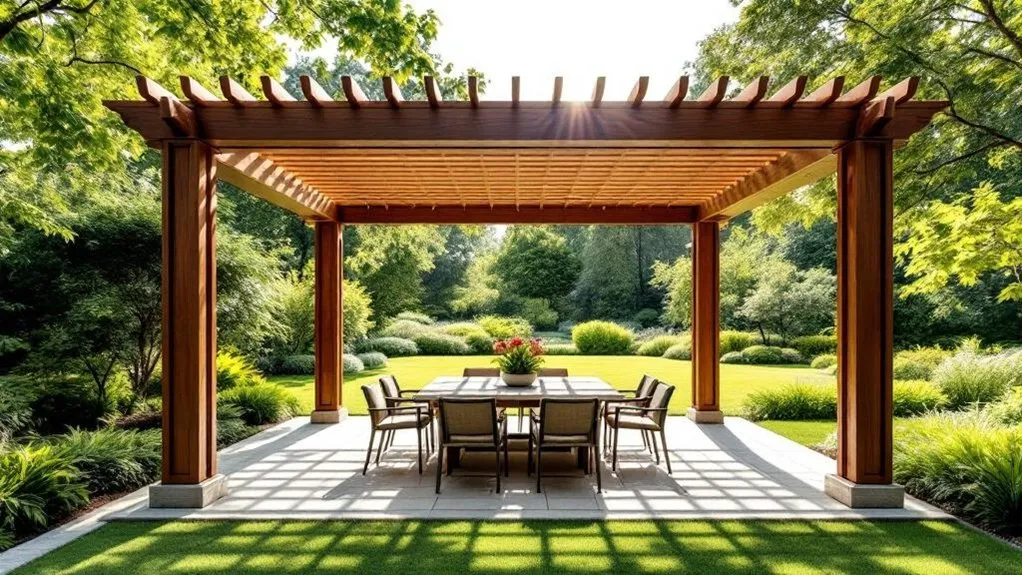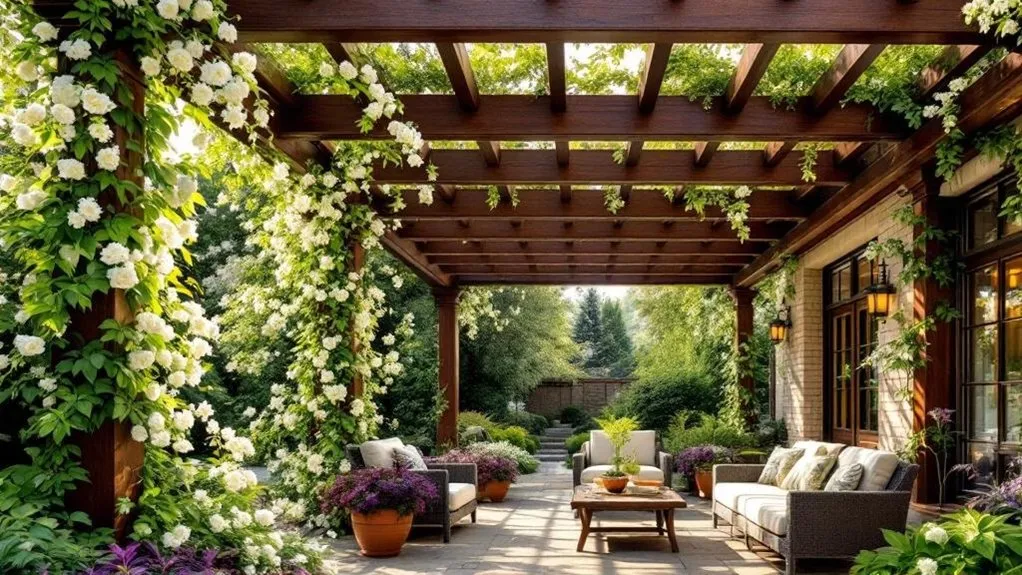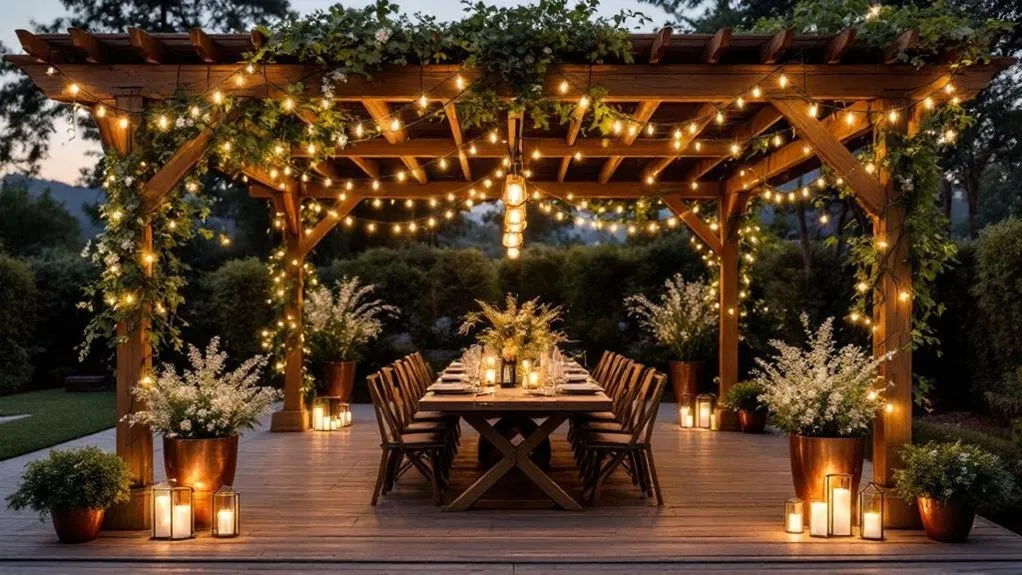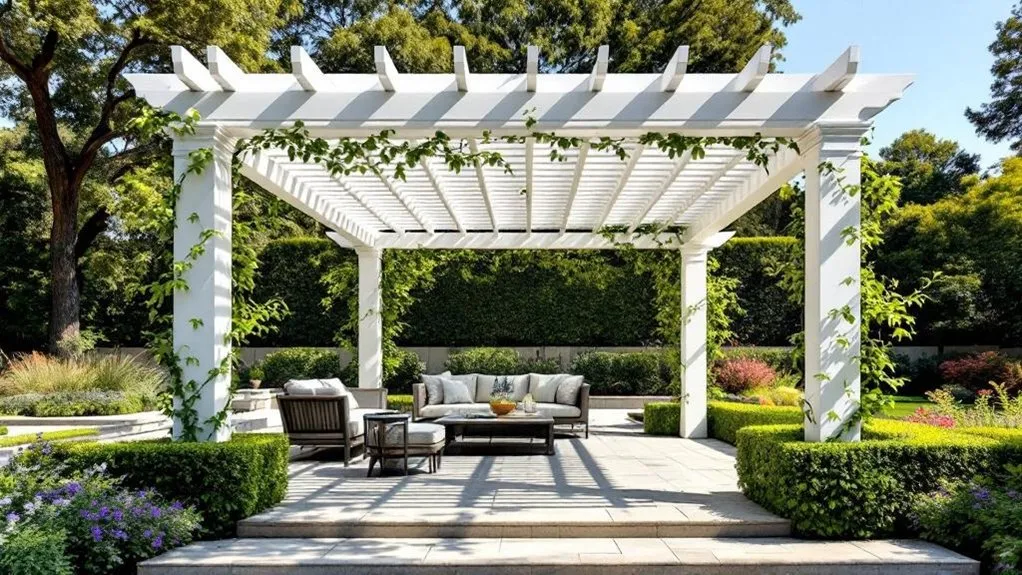Your backyard holds untapped potential that’s waiting to be transformed into something extraordinary. While you’ve probably considered various outdoor improvements, there’s one addition that can instantly elevate your space from ordinary to remarkable—a pergola. This architectural feature doesn’t just provide structure; it creates an entirely new outdoor experience that’ll change how you view and use your property. The transformation happens faster than you’d expect, and here’s exactly how it works.
Key Takeaways
- Strategic pergola placement organizes chaotic outdoor areas into functional zones for dining, lounging, or cooking spaces.
- Pergolas offer essential weather protection through fabric panels, retractable canopies, or climbing vines, providing comfortable shade.
- Climbing plants create a living canopy that enhances privacy while attracting beneficial wildlife to enrich your garden.
- Choose pergola styles that complement your home’s architecture, from sleek modern designs to ornate Victorian structures.
- Strategic lighting, like string lights and pendant fixtures, creates an inviting atmosphere for evening outdoor entertainment.
Define Your Outdoor Living Zones With Strategic Placement

Strategic pergola placement transforms chaotic outdoor areas into well-defined functional zones that serve specific purposes.
You’ll create distinct spaces by positioning your pergola over dining areas, lounging spots, or outdoor kitchens. This architectural element acts as a natural room divider without blocking airflow or views.
Consider your yard’s traffic flow when selecting placement. You don’t want guests walking through your dining zone to reach the pool.
Instead, position your pergola to guide movement around activity areas. The structure’s vertical presence naturally signals where one zone ends and another begins, creating intuitive boundaries that organize your outdoor space efficiently.
Create Natural Shade and Weather Protection
Beyond defining outdoor zones, pergolas deliver essential weather protection that extends your time outdoors throughout the seasons.
You’ll create comfortable shade by adding fabric panels, retractable canopies, or climbing vines to your pergola’s framework. These additions block harsh UV rays while maintaining airflow underneath.
During light rain, your pergola provides partial shelter, letting you stay outside longer.
You can enhance protection by installing clear polycarbonate panels or outdoor curtains that you’ll draw when needed.
Strategic placement near your home’s exterior walls maximizes natural wind barriers, creating a more sheltered microclimate for relaxation and entertainment.
Transform Your Space With Climbing Plants and Greenery

While pergolas provide an excellent structural framework for weather protection, they become truly spectacular when you integrate climbing plants and greenery into their design.
You’ll create a living canopy that evolves throughout seasons, offering enhanced privacy and natural beauty. Consider fast-growing vines like clematis, jasmine, or wisteria for quick coverage, or choose grapevines for both shade and fruit.
Training plants up the posts and across beams transforms your pergola into an outdoor room that feels intimate and secluded.
The combination of structured wood and organic plant growth creates visual interest while attracting beneficial wildlife to your garden space.
Choose the Perfect Pergola Style for Your Home’s Architecture
When selecting a pergola style, you’ll want to guarantee it complements your home’s existing architectural features rather than competing with them.
Modern homes pair beautifully with sleek, minimalist pergolas featuring clean lines and metal construction.
Traditional houses benefit from classic wooden structures with decorative brackets and curved elements.
Mediterranean-style homes shine with arched pergolas using natural stone or stucco columns.
Victorian architecture calls for ornate designs with intricate woodwork and detailed trim.
Consider your home’s materials, colors, and proportions when choosing. A well-matched pergola creates seamless visual flow between indoor and outdoor spaces, enhancing your property’s overall aesthetic appeal.
Enhance Ambiance With Lighting and Decorative Elements

Once you’ve established your pergola’s structural foundation, you can transform it into an enchanting focal point through strategic lighting and carefully chosen decorative elements.
The right ambiance creates an inviting atmosphere that extends your outdoor enjoyment well into the evening hours.
Consider these lighting options to maximize your pergola’s appeal:
- String lights draped across beams create warm, romantic illumination perfect for dinner parties
- Pendant lights hung from the structure provide focused task lighting for dining areas
- Solar lanterns placed on posts offer eco-friendly ambient lighting without electrical work
Add climbing plants, outdoor curtains, or decorative screens to complete your personalized outdoor sanctuary.
Maximize Functionality With Built-In Features and Accessories

Beyond creating visual appeal, your pergola can serve as a multi-functional outdoor room by incorporating built-in features and strategic accessories that enhance both comfort and practicality.
| Feature | Benefits | Best Applications |
|---|---|---|
| Built-in Seating | Space-saving, permanent solution | Small patios, cozy corners |
| Storage Benches | Dual-purpose functionality | Pool areas, dining spaces |
| Integrated Planters | Natural boundaries, greenery | Privacy screens, herb gardens |
| Retractable Canopy | Weather protection, shade control | Dining areas, lounging zones |
| Electrical Outlets | Power for devices, appliances | Entertainment spaces, kitchens |
You’ll transform your pergola into an all-encompassing outdoor living solution that maximizes every square foot while providing year-round usability.
Increase Property Value and Curb Appeal
A well-designed pergola can boost your property value by 5-10% while dramatically enhancing your home’s curb appeal from the street.
This outdoor structure creates an instant focal point, transforming your yard into a sophisticated living space that potential buyers will notice.
Real estate professionals consistently rank pergolas among the top landscaping features that attract buyers:
- Architectural Interest – Creates visual depth and frames your outdoor space beautifully
- Defined Living Areas – Establishes clear boundaries between lawn and entertainment zones
- Premium Appearance – Signals quality craftsmanship and attention to detail
You’ll enjoy immediate aesthetic benefits while building long-term equity in your home investment.
Frequently Asked Questions
What Permits Are Required for Pergola Installation in My Area?
You’ll need to check with your local building department since permit requirements vary by location.
Most areas require permits for pergolas over a specific size or height, typically 10×10 feet or 8 feet tall.
You’ll likely need building permits, and possibly electrical licenses if you’re adding lighting.
Contact your city’s planning office or visit their website to get specific requirements for your area.
Don’t skip this step – unpermitted structures can cause problems later.
How Much Does It Typically Cost to Install a Pergola?
You’ll typically spend between $2,000 $6,000 for a basic pergola installation, though costs vary considerably based on materials and size.
If you’re choosing premium materials like cedar or adding electrical features, you could pay $8,000 to $15,000 or more.
DIY kits start around $500 to $1,500, but you’ll need proper tools and skills.
Professional installation adds $1,000 to $3,000 in labor costs, ensuring proper construction and warranty coverage.
What Maintenance Is Required to Keep a Pergola in Good Condition?
To keep your pergola looking great, you’ll need to perform regular maintenance.
Clean it annually with mild soap and water, removing dirt and debris. Check for loose bolts and tighten them as needed.
If it’s wooden, you’ll want to stain or seal it every 2-3 years to prevent weathering.
Trim any climbing plants that might damage the structure, and inspect for pest damage or rot regularly.
How Long Does a Pergola Installation Typically Take from Start to Finish?
You’ll typically need 1-3 days for pergola installation, depending on size and complexity.
Simple kit installations can be completed in a weekend, while custom builds require more time. Weather conditions and ground preparation also affect the timing.
If you’re hiring professionals, they’ll handle permits and foundation work first, then assembly.
DIY projects take longer since you’re learning as you go. Planning and having all materials ready significantly speeds up the process.
Can I Install a Pergola Myself, or Do I Need Professionals?
You can install a pergola yourself if you’re handy with tools and have basic construction experience.
DIY kits make installation easier with pre-cut materials and detailed instructions. However, you’ll need helpers for lifting heavy beams and posts.
Consider hiring professionals if you’re dealing with complex electrical work, concrete footings, or local building permits.
Professional installation guarantees proper structural integrity and typically comes with warranties, though it’ll cost more than doing it yourself.
